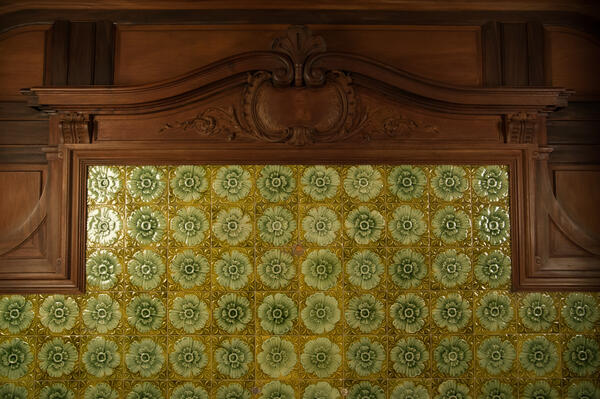By the early 1900s Massandra palace was considered one of the most technically equipped palaces of the Southern Coast of Crimea, so the bathrooms were an essential part of the palace layout. This bathroom had been made for Empress Maria Feodorovna, spouse of Emperor Alexander III, and like other rooms in the palace, it had been richly decorated.
The bathroom wall is covered with majolica tiles and bordered by a wooden frame. The top of the frame holds a carved medallion in its center. Originally, this medallion included the monogram of Empress Maria Feodorovna which is now gone. The medallion is flanked with two symmetrical carved scrolls.
Glazed ceramic wall tiles are the centerpiece of the bathroom. Each of the Dutch-made tiles has a stylized relief rosette in green gradient colors.
Majolica, from which the craft takes its name, is the distorted Italian pronunciation of the Spanish island of Majorca. It was in Majorca that in 1115 the Genoese first found Hispano-Moresque ceramic vessels and glazed tiles. These objects were taken to Italy and served as samples for the first majolica experiments by Italian potters.
In search for the cradle of majolica pottery we must look to Pisa, where the first imitations of Moresque, Arabic and Persian glazed works appeared. The technique spread widely across Europe during the Middle Ages, and by the 15th century the craft was handed down from father to son in the long lines of Dutch artisans.
Majolica production reached its apex in the 18th century Holland with around thirty active factories. Early Dutch wall tiles from the middle of 16th – early 17th centuries were very similar to the Mediterranean floor tiles. Both types have distinct rich flower decoration made in typical Renaissance colors: green, orange, yellow, blue and purple. The tile motifs also resonate with Moorish textiles from Spain.
During the 16th-17th centuries the tile shape changed from square to rectangular to lozenge. Dutch tiles were used in interior decoration in many countries, exported and copied worldwide, including Russia.
The bathroom wall is covered with majolica tiles and bordered by a wooden frame. The top of the frame holds a carved medallion in its center. Originally, this medallion included the monogram of Empress Maria Feodorovna which is now gone. The medallion is flanked with two symmetrical carved scrolls.
Glazed ceramic wall tiles are the centerpiece of the bathroom. Each of the Dutch-made tiles has a stylized relief rosette in green gradient colors.
Majolica, from which the craft takes its name, is the distorted Italian pronunciation of the Spanish island of Majorca. It was in Majorca that in 1115 the Genoese first found Hispano-Moresque ceramic vessels and glazed tiles. These objects were taken to Italy and served as samples for the first majolica experiments by Italian potters.
In search for the cradle of majolica pottery we must look to Pisa, where the first imitations of Moresque, Arabic and Persian glazed works appeared. The technique spread widely across Europe during the Middle Ages, and by the 15th century the craft was handed down from father to son in the long lines of Dutch artisans.
Majolica production reached its apex in the 18th century Holland with around thirty active factories. Early Dutch wall tiles from the middle of 16th – early 17th centuries were very similar to the Mediterranean floor tiles. Both types have distinct rich flower decoration made in typical Renaissance colors: green, orange, yellow, blue and purple. The tile motifs also resonate with Moorish textiles from Spain.
During the 16th-17th centuries the tile shape changed from square to rectangular to lozenge. Dutch tiles were used in interior decoration in many countries, exported and copied worldwide, including Russia.



